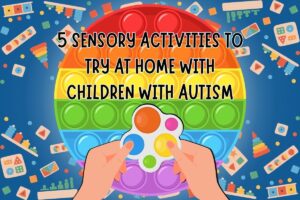Why Is Play Important for Kids Diagnosed With ASD
Play is an essential part of childhood development, but it holds an even greater significance for children with autism who may struggle with social skills, communication, and behavior. However, play provides numerous opportunities for these children to learn and grow these skills.
Through play, children with autism improve their social skills by learning how to take turns, share, read social cues, and interact with others. Using imagination helps strengthen emotional regulation and how to express and communicate thoughts and feelings. It can also help you develop fine and gross motor skills, which can have a positive impact on their daily activities.
How to Encourage Play
It’s important to understand that play is not just about using toys. Play is about interaction. Meaning you engage in the same activities with joint attention on the game or toy. It doesn’t matter what the item is, it’s all in your imagination anyways!
These activities can range from creative forms of art and music to participating in recreational physical activities like playing sports or hiking. The only important factor is to embrace what fascinates your child and let them make the choice.
Making Sense of Sensory Activities
Sensory activities are designed to stimulate and engage a child’s senses. For children with autism, who often struggle with sensory processing issues, these toys and activities can be especially helpful in promoting relaxation, reducing anxiety, and improving focus and attention.
Sensory toys can take many different forms, including:
-
Fidget spinners
-
Weighted blankets
-
Slime
-
Finger painting
-
And anything involving the senses
These are designed to provide a calming or stimulating sensory experience that can help regulate a child’s emotions and behavior.
Some Fun, Easy At-Home Sensory Activities
Here are some simple and fun activities you can do with items you most likely have around the house already. Keep in mind that children with autism may find it helpful to have someone demonstrate the activity for them before trying it themselves.
1. Make Your Own Slime
With just a few ingredients and following two simple steps, you can make your own slime. This is a fun activity for children who love squishy feelings. With an extra ingredient or two, you can add a scent to it as well.
The first step is to cover your table with a tablecloth or placemats for easy cleanup. Next, pour the glue into a medium bowl. Stir in any optional additives like glitter, food coloring, or scents. Slowly add in baking soda and continue stirring until smooth. Then add two tablespoons of the saline solution and continue stirring. The mixture will start to harden and form balls of slime.
Remember to wash your hands and avoid touching your mouth while creating and playing with the slime. Also, be sure to soak all the mixing tools in warm water to help dissolve the glue.
 2. Sensory Bottles
2. Sensory Bottles
Making a sensory bottle means a lot of creative freedom. Generally, it’s a bottle that we fill with different materials, such as a water and glue mixture, that generates a variety of sensations when moved around. For example, an ocean-themed sensory bottle could have sand, shells, and sea critter toys in it.
The steps for this one are simple. Combine the ingredients in a water bottle, seal it, and shake. The real fun is making each bottle unique and themed.
3. Rubbing Art
Rubbing art is a fun and simple craft that helps children develop hand-eye coordination, strengthen their hand muscles, and explore textures, shapes, and colors.
Simply place coins, sandpaper, leaves, or other flat, textured objects under a sheet of paper. Tape it down to secure the paper if you wish. Use crayons or a pencil to rub over the textures to reveal a pattern. Take this activity a step further by incorporating numbers, different colors, and a variety of textures.
4. Water Tub Colors
Warm water is comforting, and colors are soothing. So, this is a great and calming activity for children with autism. It’s fun and easy and can be a great introduction for your child to learn the principles of color mixing, gross motor skills, visual processing, sorting, and memory.
Fill the tubs halfway with water, soap, and add different colors to each one. Then, using the cups, label them with the same colors and have your child match the colors. Encourage them not to spill anything and fill up all the cups with the same colors. After, let them experiment with creating different colors by mixing them.
5. Sensory Bins
Sensory bins are one of the most versatile options for sensory activities for children diagnosed with autism. The options are endless, but we will explain a more simplistic one.
The goal here is to expose your kid to as many different textures as possible and allow them to feel and see them together. A simple combination of dried rice and beans could work, but it would be even better to get creative and pick a theme that suits your child’s interests, like dinosaurs buried in the sand.
Just Feel It Out
Every child is different and will have different preferences, so take your time and let your child try these new activities. Remember to tailor the activities to their interests, try different options, and listen to your child’s wants and needs. Let them come up with ideas, or if they don’t like something – try something else!




 2. Sensory Bottles
2. Sensory Bottles




